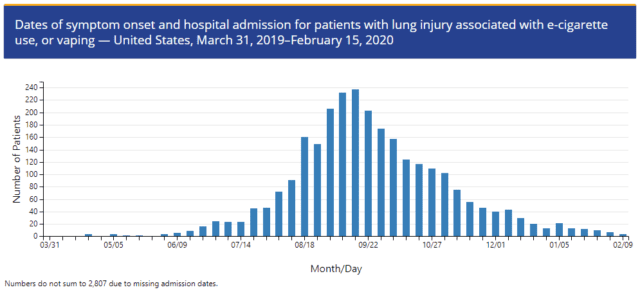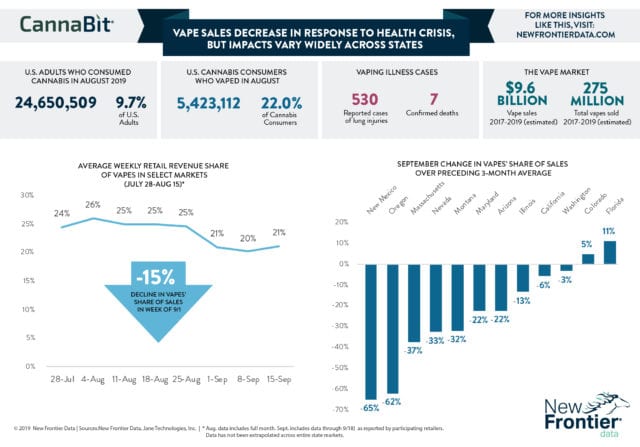In the age of social media, misinformation is becoming more and more common. Unfortunately, facts frequently face intense scrutiny and are sometimes just brushed aside. This is an occurrence we see often with extremely polarizing issues, and this is what leads us to the tug of war we are seeing in the world of vaping — with its tremendous rise in popularity over the past couple of years, there has been an intense focus on both the risks and benefits that come from vaping. This focus was magnified in 2019 when we were faced with a full-blown, vape-related lung disease epidemic.
According to the Centers for Disease Control, the first vaping-associated lung illnesses were identified in Illinois and Wisconsin in April 2019, with cases peaking in September 2019 and slowly declining thereafter. In all, the CDC reported that there were a total of 2,807 hospitalized cases, including 60 confirmed deaths, as of February 2020.

The alarming number of cases not only made headline news but also left many companies in the vaping industry scrambling to find solutions. Southern California-based FLO is one company taking initiative on the issue — FLO believes it has perfected its vaping cartridge offerings to not only deliver a flawless product but also give consumers peace of mind that they won’t risk going to the hospital with a vaping-related lung illness.
An epidemic of counterfeit & shoddy vaporizers
So, what exactly are the issues that FLO, and many other vaping companies, are up against? For one, things were so serious that the US government considered completely regulating the vaping industry by removing all flavored vaping products. Instead, the government raised the legal age requirement for tobacco and vaping products to 21.
But while raising the legal smoking age does make it slightly more difficult for teenagers to get their hands on smoking products, it still doesn’t accurately depict the issues with these vaping products in the first place. According to the CDC, the median age of individuals hospitalized with severe vaping-related lung illnesses was 24 years old. Furthermore, 79% of hospitalizations and deaths were of persons under 35 years old, with ages ranging from 13 to 75 years. These numbers illustrate that any age is at risk, so raising the legal age to 21 doesn’t necessarily solve the issue stemming from the epidemic.
Raising the legal age is a positive, especially considering the alternative proposal, but it’s important to truly understand what the main culprits of the vaping epidemic were.
One issue likely stemmed from vitamin E acetate — which is commonly used as an additive or thickening agent — being used in counterfeit vaping products. Research shows that while vitamin E acetate is used in supplements and skin creams and does not cause harm when swallowed or used topically, the chemical can impair people’s lung function when inhaled. According to health officials with the CDC, the chemical turned up in “every sample of lung fluid collected from 29 patients with vaping-related illnesses in 2019” and was being used as an ingredient in many counterfeit THC products. The fact that vitamin E acetate was found in every sample from 2019 could also explain why the epidemic sprung up suddenly that year and not before, even though vaping had been around for much longer.
But we shouldn’t be so quick to blame this just on vitamin E acetate because, according to Kathleen Raven of Yale Medicine, “officials stressed their findings remain inconclusive, and more than one chemical could be contributing to lung damage.” In a Scientific Reports study by Monique Williams, researchers conducted a topography on chemical elements and metals in the aerosol of tank-style e-cigarettes. The aim of this study was to examine other vaping-related culprits that may have led to lung illnesses. Researchers found a bevy of heavy metals in these vapors, including aluminum, copper, calcium, chromium, iron, lead, magnesium, nickel, silicon, tin, and zinc. They determined that the liquid is heated in these e-cigarettes, the metals essentially leach from the heating coil. Ultimately, the more metal parts there are in an e-cigarette, the higher the likelihood heavy metals are going to be present.
What happened?
So, was cheap material at least partially to blame? According to Michael Blood of the Associated Press, “Bootleggers eager to profit off unsuspecting consumers are mimicking popular, legal vape brands, pairing replica packaging churned out in Chinese factories with untested, possibly dangerous cannabis oil produced in the state’s vast underground market.”
China is the world’s biggest manufacturer and exporter of e-cigarettes, according to the China Electronic Cigarette Chamber of Commerce, and the country has been a frequent target of criticism due to the number of counterfeit and unregulated vaporizers being manufactured there. There have been numerous lawsuits against vaping manufacturers from China, including some by American companies. According to a May 2020 press release, “DS Technology Licensing, the owner of registered trademarks associated with the ‘Puff Bar’ vapor device, and Puff Inc., an authorized US distributor, filed a lawsuit in Los Angeles County Superior Court against over 20 Chinese and American companies accused of distributing counterfeit vaping devices.”
The firestorm of illnesses and the fear of cheap counterfeit products led to a dramatic drop in e-cigarette sales. Jane Technologies Inc. reported in 2019 that the market share for vapes was down 15% in medical states including Oregon and states with high levels of cannabis tourism such as Nevada and Massachusetts showing the worst declines. Furthermore, vapes’ share of sales fell 65% in New Mexico, 62% in Oregon, 37% in Massachusetts, and 32% in Nevada. As the illnesses wore on in 2019, so did the decline in vape sales across the country.

And to be frank, this was all largely expected with the 24-hour news cycle churning out one negative article about vaping after another. Eventually, Chinese e-commerce sites like Alibaba noticed the outcry and removed e-cigarette components for the United States. According to a Reuters report, Alibaba began to feel pressure as their lack of regulating what was sold on their site came into the spotlight amid “many reports of death and injury in the United States” being tied to “makeshift brands with no identifiable owner.” Before the products were removed, it was very easy for consumers to hop on Alibaba and purchase devices, component parts, and packaging from the site — the move to suspend these sales spoke volumes to their connection to the counterfeit products. Another Chinese e-commerce site, DHGate, has also been accused of allowing counterfeit vaping products to be sold with no regulation. So, this is definitely a problem that even permeates the e-commerce world.
Localizing the US vape industry
Considering all of the issues above, legitimate vaping companies must take steps to ensure that their products are both safe and reliable. One strategy companies are pursuing is to create vaping cartridges that are free of heavy metals.
How does this circle back to FLO and its mission to put forth a reliable and trustworthy product? By assembling all their vaping cartridges locally, the company leadership is able to oversee the entire operation and make sure all regulations and standards are met. This is in contrast to many other vaping companies who go through China-based manufacturers and who sometimes must deal with the repercussions of inadequate material.
To combat the issues that other companies have faced with their vaping cartridges, FLO uses extremely heat-resistant organic Plexiglass, which contains zero heavy metals. FLO has also perfected the exact diameter thickness and heating resistance, and equipped the cartridges with patented ceramic coil technology that allows for perfect heating temperatures and will not leave a smell after use, and offers more-than-adequate airflow. Another important factor to FLO’s glass cartridges is that they are tamper-proof after being assembled, whereas many glass cartridges that can be screwed back out from the bottom have cause leakages when consumers attempt to unscrew the battery from the cartridge only to unscrew the cap that holds the whole cartridge together.
Ultimately, vaping is not going to land on anyone’s “most healthy” list. The fact is there will always be risks. But trustworthy and diligent companies like FLO do everything in their power to mitigate these risks as much as possible. Adult smokers need alternatives to cigarettes and giving them a safer and more reliable option is still important. FLO is leading the charge into a new era of vaping where counterfeits, heavy metals, and inadequate products are the furthest things from the consumer’s mind.
FLO products are available for purchase at Catalyst Dispensaries in LA and OC County.
End
